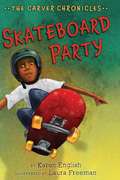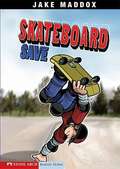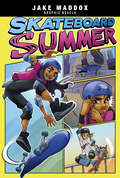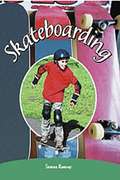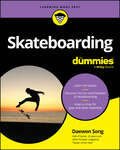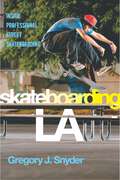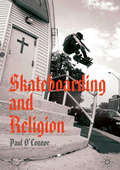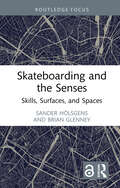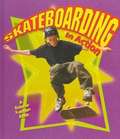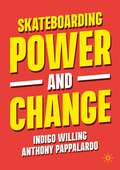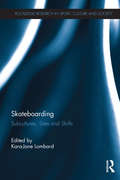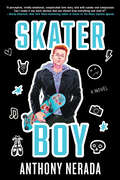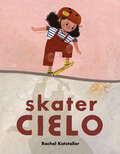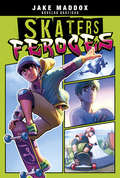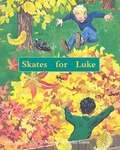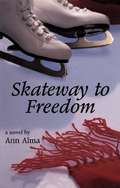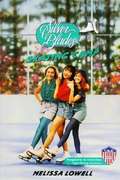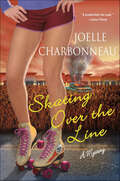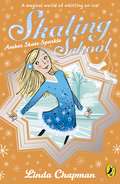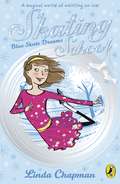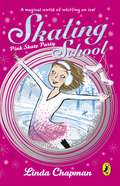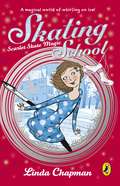- Table View
- List View
Skateboard Party (Carver Chronicles #2)
by Karen English Laura FreemanRichard can't wait to show off his flat-ground Ollies at a friend's birthday party at the skate park, but a note home from his teacher threatens to ruin his plans. He really meant to finish his assignment on howler monkeys, but he just got . . . distracted. If only he could focus on his schoolwork, he wouldn't get into this kind of trouble! Can Richard manage to put off getting the note signed (and facing the consequences) until after the party, or will the deception make things even worse? Nikki and Deja fans and their male peers are sure to recognize themselves and their classmates in this humorous school story.
Skateboard Save
by Jake Maddox Eric StevensWhen Riley enters the skateboarding contest, he doesn't expect to help his biggest rival.
Skateboard Summer (Jake Maddox Graphic Novels)
by Jake MaddoxSondra and her best friend, Jonathan, have finally saved up enough money to attend the summer camp of their dreams—Camp Vert. In order to fit in at the competitive skateboarding camp, the two friends decide to learn a challenging trick, the frontside 180 heelflip. When the friends’ cabins go up against one another in competition, will they both master the trick? And more importantly, will they stay friends in the middle of the rivalry?
Skateboarding (Rigby PM Collection Ruby (Levels 27-28), Fountas & Pinnell Select Collections Grade 3 Level Q)
by Rigby StaffStudent Reader Skateboarding
Skateboarding For Dummies
by Daewon SongA beginner’s guide to skating for fun, fitness, and self-expression Skateboarding For Dummies teaches you the basics of the fun and popular sport of skateboarding, so you can start shredding. Author Daewon Song has been a pro skateboarder for 30 years and is considered to be the most technically gifted skateboarder of all time. He is passionate about the sport and shares his enthusiasm and experience in this easy-to-read guide. Skateboarding is a fun, challenging, and inclusive sport that can also be a powerful outlet for self-expression. With this book, you’ll learn cool tricks, safe skating, and skatepark etiquette. Plus, you’ll discover how skateboarding can bring positivity to your life, building your confidence and self-esteem. Shop for your first skateboard and essential accessories Learn the basics of riding a skateboard at a skatepark Get step-by-step instructions for performing classic tricks Discover the history of skateboardingSkateboarding is for everyone, regardless of age or background, and Skateboarding For Dummies is for anyone who wants to give this sport a try.
Skateboarding LA: Inside Professional Street Skateboarding (Alternative Criminology #10)
by Gregory J. SnyderInside the complex and misunderstood world of professional street skateboardingOn a sunny Sunday in Los Angeles, a crew of skaters and videographers watch as one of them attempts to land a “heel flip” over a fire hydrant on a sidewalk in front of the Biltmore Hotel. A staff member of the hotel demands they leave and picks up his phone to call the police.Not only does the skater land the trick, but he does so quickly, and spares everyone the unwanted stress of having to deal with the cops. This is not an uncommon occurrence in skateboarding, which is illegal in most American cities and this interaction is just part of the process of being a professional street skater. This is just one of Gregory Snyder’s experiences from eight years inside the world of professional street skateboarding: a highly refined, athletic and aesthetic pursuit, from which a large number of people profit. Skateboarding LA details the history of skateboarding, describes basic and complex tricks, tours some of LA's most famous spots, and provides an enthusiastic appreciation of this dangerous and creative practice. Particularly concerned with public spaces, Snyder shows that skateboarding offers cities much more than petty vandalism and exaggerated claims of destruction. Rather, skateboarding draws highly talented young people from around the globe to skateboarding cities, building a diverse and wide-reaching community of skateboarders, filmmakers, photographers, writers, and entrepreneurs. Snyder also argues that as stewards of public plazas and parks, skateboarders deter homeless encampments and drug dealers. In one stunning case, skateboarders transformed the West LA Courthouse, with Nike’s assistance, into a skateable public space.Through interviews with current and former professional skateboarders, Snyder vividly expresses their passion, dedication and creativity. Especially in relation to the city's architectural features—ledges, banks, gaps, stairs and handrails—they are constantly re-imagining and repurposing these urban spaces in order to perform their ever-increasingly difficult tricks. For anyone interested in this dynamic and daunting activity, Skateboarding LA is an amazing ride.
Skateboarding and Femininity: Gender, Space-making and Expressive Movement (Routledge Advances in Theatre & Performance Studies)
by Dani AbulhawaSkateboarding and Femininity explores and highlights the value of femininity both within skateboarding and wider culture. This book examines skateboarding’s relationship to gender politics through a consideration of the personal politics connected to individual skateboarders, the social-spatial arenas in which skateboarding takes place, and by understanding the performance of tricks and symbolic movements as part of gender-based power dynamics. Dani Abulhawa anaylses the discursive frameworks connected to skateboarding philanthropic projects and how these operate through gendered tropes. Through the author’s work with skateboarding charity SkatePal, this book offers an alternative way of recognising the value of skateboarding philanthropy projects, proposing a move toward a more open and explorative somatic practice perspective.
Skateboarding and Religion
by Paul O'ConnorThis book explores the ways in which religion is observed, performed, and organised in skateboard culture. Drawing on scholarship from the sociology of religion and the cultural politics of lifestyle sports, this work combines ethnographic research with media analysis to argue that the rituals of skateboarding provide participants with a rich cultural canvas for emotional and spiritual engagement. Paul O’Connor contends that religious identification in skateboarding is set to increase as participants pursue ways to both control and engage meaningfully with an activity that has become an increasingly mainstream and institutionalised sport. Religion is explored through the themes of myth, celebrity, iconography, pilgrimage, evangelism, cults, and self-help.
Skateboarding and the Senses: Skills, Surfaces, and Spaces (Routledge Focus on Sport, Culture and Society)
by Brian Glenney Sander HölsgensThis book presents a new perspective on skateboarding, centred on the senses, skill acquisition, embodiment, and the concept of "city craft".Skateboarding and the Senses traces how skaters use their skilled bodies to bring vitality to contested spaces. Building on sensory anthropology, the book draws connections between the diverse ways skaters move and their boundless drive for social action – from rebellious interventionism to a critical engagement with sportification and the Olympics. Coalescing around skateboarding’s pedagogy of enskilment, the book examines what to make of the skater’s way of sensing the city, of their bruised heels and scabbed elbows and of their sensory attunement to their friends and foes. Grounded in historical, anthropological, and phenomenological theories of body and space, it examines how skaters acquire somatic knowledge and socio-emotional resilience through their sonic and vibratory experience of the city streets. This sensory anthropology of skateboarding reveals new insights into its long arc of subculture, lifestyle, and sport.This is essential reading for anybody with an interest in the sociology, culture or history of sport, urban geographies, sensory studies, or social and cultural anthropology.
Skateboarding in Action
by Bobbie Kalman John CrossinghamSkateboarding in Action shows kids how to get moving! What began as a way for surfers to practice on land has become one of North America's most popular sports.
Skateboarding, Power and Change
by Indigo Willing Anthony PappalardoThis book explores how cultural, social and political change happens through a unique analysis of the ‘ethical turn’ in skateboarding today. Insights shared by key change-makers and industry insiders cover themes including First Nations, Black and People of Color, skater-run creative innovations, anti-colonialism, anti-racism initiatives, and a growing focus on equity and empowering skaters historically discriminated against due to gender and/or sexuality. These dynamic changes are also connected to conceptual and theoretical frameworks from skate research, journalism, and sociology. This is a must-read for anyone interested in subcultures and social change.
Skateboarding: Subcultures, Sites and Shifts (Routledge Research in Sport, Culture and Society)
by Kara-Jane LombardThis book explores the cultural, social, spatial, and political dynamics of skateboarding, drawing on contributions from leading international experts across a range of disciplines, such as sociology and philosophy of sport, architecture, anthropology, ecology, cultural studies, sociology, geography, and other fields. Part I critiques the ethos of skateboarding, its cultures and scenes, global trajectory, and the meanings it holds. Part II critically examines skateboarding in terms of space and sites, and Part III explores shifts that have occurred in skateboarding’s history around mainstreaming, commercialization, professionalization, neoliberalization and creative cities.
Skater Baby
by Jack NoelIn this hilarious picture book debut, a precocious baby sneaks away from her mom, snags a skateboard, and begins one heck of a daring (and disruptive) joyride through the park!Mom wants her precious little bundle to have some good, safe fun at the park—but Baby has other plans. While her mom isn't looking, the baby crawls away and finds a skateboard. As Skater Baby goes on a fun-filled joyride through the park, she continues to pass one distracted, unsuspecting adult after another and snags something new from each of them (like an umbrella, a clown's nose, and even an unsupervised dog). While her haul steadily grows, so does the crowd of adults who are chasing after. But no one seems to be able to catch the daredevil tyke. And wait, is Skater Baby heading for the huge, scary Mega Ramp?
Skater Boy
by Anthony NeradaIn this YA pop punk debut about queer romance and destroying labels, a teen risks everything to write his own story. Perfect for fans of Sonora Reyes and Adib Khorram.Stonebridge High&’s resident bad boy, Wesley &“Big Mac&” Mackenzie, is failing senior year—thanks to his unchecked anger, rowdy friends, and a tendency to ditch his homework for skateboarding and a secret photography obsession. So when his mom drags him to a production of The Nutcracker, Wes isn&’t interested at all . . . until he sees Tristan Monroe. Mr. Nutcracker himself.Wes knows he shouldn&’t like Tristan; after all, he&’s a ballet dancer, and Wes is as closeted as they come. But when they start spending time together, Wes can&’t seem to get Tristan out of his head. Driven by a new sense of purpose, Wes begins to think that—despite every authority figure telling him otherwise—maybe he can change for the better and graduate on time.As a falling out with his friends becomes inevitable, Wes realizes that being himself means taking a stand—and blowing up the bad-boy reputation he never wanted in the first place.From a debut author to watch, Skater Boy delivers a heart-wrenching, validating, and honest story about what it means to be gay in a world where you don&’t fit in.
Skater Cielo
by Rachel KatstallerMeet Cielo, a fierce skater who finds that facing your fear of failing gives you the courage to persevere! Cielo loves to skateboard! But when she messes up on a new ramp she's embarrassed and afraid to fall again in front of so many people. With the help of some new friends, Cielo summons the courage to try again (and again, and again), and learns that falling is not failing--true fierceness isn't about landing the perfect trick, it's about picking yourself back up when you don't.
Skaters feroces (Jake Maddox Novelas gráficas)
by Jake MaddoxAdnan Zakaria's family recently fled Syria and resettled in America. Adnan feels like a stranger in a strange land. He's lonely and homesick. The one thing that gives him comfort is his best friend's skateboard that he brought with him from Syria. As Adnan navigates his new community, he bonds with new friends at a local skatepark. But he also faces adversity in the form of local troublemaker Mike Proctor. After Adnan loses his precious skateboard one evening, he learns that Mike Proctor has it and won't give it up without a challenge. Will Adnan be able to out-skate his foe and reclaim his board? And will the two boys learn to respect one another, in spite of their differences? Combining a high-stakes sports story with a dynamic full-color comic format, this Jake Maddox Graphic Novel is sure to be a win for young athletes and struggling readers alike. Fully translated Spanish text.
Skateway to Freedom
by Ann AlmaShort-listed for the 1995 Silver Birch Award Eleven-year-old Josie Grun escapes from Communist East Germany with her mother and father one dark night in 1989 just months before the Berlin Wall comes tumbling down. Braving border guards, barbed wire, and rifle shots, Josie reluctantly turns her back on her best friend, Greta, and all that was once familiar. She crosses the ocean to join her uncle in Calgary, attempts to learn a foreign language, and overcomes the prejudices of her schoolmates in order to forge a new life. Clinging to the passion that has always been a comfort, her figure skating, she enters a local competition to prove that she is free on the ice and off.
Skating (Merit Badge Series)
by Boy Scouts of AmericaSkating activities present inherent safety concerns, primarily the risk of falls and collisions. The guidelines in this book emphasize prevention and are meant to cover all BSA skating programs. Scouts should always practice safety and courtesy and obey all local and rink or park rules. Every Skating merit badge program or activity must follow the BSA guidelines, which are set forth in the Guide to Safe Scouting and are repeated here.
Skating Camp (Silver Blades, #6)
by Melissa LowellSummer's here and Jill Wong can't wait to join her best friends from Sliver Blades at skating camp. It's going to be just like old times. But things have changed since Jill left Silver Blades to train at a famous ice academy. Tori and Danielle are spending all their time with another skater, Haley Arthur, and Nikki has a big secret that she won't share with anyone. Has Jill lost her three best friends forever?
Skating Over the Line: A Mystery (Rebecca Robbins Mysteries #2)
by Joelle CharbonneauRebecca Robbins is desperate to sell her inherited roller-skating rink in small-town Indian Falls, and---finally---she has a buyer. She can't wait to head back to Chicago, especially now that her long delinquent father has blown back into town, but Lionel, her veterinarian boyfriend, thinks she should stay put. Also, the gang at the Senior Center wants her to track down the thief who's been hot-wiring rusted-out classic cars. Unable to resist, Rebecca soon has the Sheriff's Deputy threatening to arrest her for obstruction, and strange but scary men threatening her life. Then cars start exploding, with people in them, and Rebecca's father goes missing. With the help of Pop, her Elvis-impersonating grandfather, Rebecca must find the pyromaniac car thief and put a stop to him---before he stops her first.Skating Over the Line is the second novel in a delightful cozy series filled with small town charm and delicious laughs.
Skating School: Amber Skate Star
by Linda ChapmanWelcome to a magical world where dreams come true. . . Brand new pupils arrive at the magical skating school for some sparkling new adventures!
Skating School: Blue Skate Dreams (Skating School Ser.)
by Linda ChapmanWelcome to a magical world where dreams come true . . .Emily and her skating-school friends are thrilled to be learning to drive sledges pulled by fluffy huskies. The competition that week to win the blue skates is a winter sledge-ski-skate race! The girls have to choose the best person in their team for each leg of the race, but will they discover that winning the race isn't all it takes to be Ice Princess?
Skating School: Pink Skate Party (Skating School Ser.)
by Linda ChapmanWelcome to a magical world where dreams come true . . .Emily loves dancing at ice-skating school and this week the girls get to invent their own routine - and design their costumes!Soon Emily is busy practising - but she is so eager to succeed that she forgets her friends. Will Emily remember that being a good friend means more than winning the pair of precious pink skates?
Skating School: Scarlet Skate Magic (Skating School Ser.)
by Linda ChapmanWelcome to a magical world where dreams come true . . .Emily and her skating-school friends can't wait to go on an exciting two-day scavenger hunt.The girls must work in teams and they all want to win the very special scarlet skates. But will they discover that listening to each other is even greater than winning?
